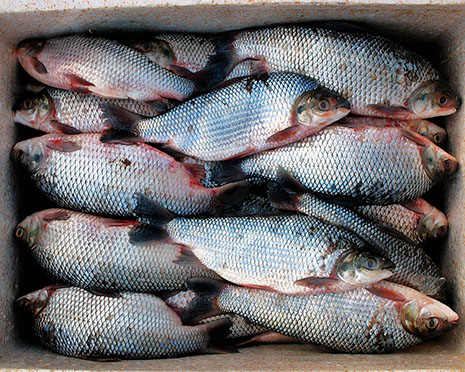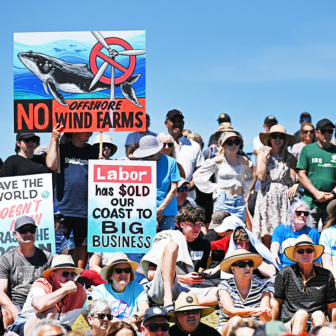THE MASSIVE EXPANSION in fishing over the past fifty years has brought the industry to the point where it faces what seems like a paradox: an immediate reduction in the catch would actually increase future profits from harvesting, perhaps by as much as US$50 billion per year. This figure reflects the fact that about a quarter of the world’s fisheries are overexploited in the biological sense: current harvests are less than they could be if fishing were reduced and stocks allowed to increase. The question is, how do we persuade the fishing industry to act in its own long-term interests?
Overfishing has contributed to stock declines so severe that about 15 per cent of all exploited capture fisheries have “collapsed” or are at less than 10 per cent of their unexploited levels. Overexploitation has changed the age structure and stability of fish populations and altered the position of exploited species in the food chain. It has changed the species composition of fish communities. And certain destructive forms of fishing have damaged marine ecosystems. As a result, the world harvest of “capture fisheries” reached a plateau in the early 1990s, at about 85 million metric tons, and much of the future supply of fish must come largely from aquaculture.
Although aquaculture already supplies about half of the fish that reach consumers, many highly valued farmed species depend on fish protein from capture fisheries for the bulk of their feed. So far, limits on the supply of fish meal have not had an appreciable impact on aquaculture’s rapid growth, but that could change for high-value farmed fish, such as salmon, if the price of fish meal rises appreciably. This would be a major concern for farm fisheries, though nowhere near as devastating as the impact of any further declines or a collapse in wild fisheries on the many poor and fishing-dependent communities that rely on fish for the bulk of their protein intake.
Some 200 million people rely on fishing and fish supply chains for their livelihoods. Managing fish stocks and conserving the marine environment on which these communities depend represent the greatest human challenge facing ocean management.
The difficulties of managing fisheries extend well beyond concerns about the fish-based industries and include environmental, ecological and biodiversity considerations. Acidification of the world’s oceans, rising sea levels, changes in salinity and water temperature, and the increased variability of ocean currents associated with climate change all represent risks that must be managed effectively to ensure the sustainability of the world’s fisheries. In all likelihood, reductions in greenhouse emissions are decades away, so we must prepare for and adapt to an increasingly uncertain ocean environment.
Overlaying these challenges is the international trade in fish, which allows high-income nations to export their marine conservation problems to lower-income countries while importing their fish to consume. The best way to face these global challenges is to resolve the present-day problems for which remedies are already available.
DESPITE THEIR DIVERSITY, almost all fisheries share four traits that offer insights into how we can implement effective marine conservation.
Fish stocks are common-pool resources. This means, first, that every time someone catches a fish they reduce the catch available to others. In the absence of property rights over the right to catch fish and effective control of fishing effort, individual fishers will tend to catch too many fish because they have no incentive to consider the costs they impose on others. This is not because fishers don’t care about sustainability of the stocks on which they depend; it is simply because conservation efforts by any one individual will simply end up benefiting someone else in the absence of effective collective management and control.
The second characteristic of a common-pool resource is that it is difficult and expensive for centralised governments or international bodies to control or limit the industry. Fishing occurs at sea and is often carried out by many different individuals, making the industry difficult to monitor and regulations difficult to enforce. The complexity is compounded in transnational fisheries and among highly migratory species, including tuna, when the harvesting is carried out by individuals from many different nations. Supervising what, when and where fish are caught is affordable only in high-value fisheries. In the absence of such coverage, managers must infer what is happening at sea.
The difficulty in implementing adequate monitoring, control, and surveillance is one reason that in many fisheries the incentives do not exist for fishers to behave in a way that promotes both their own long-term interest and the sustainability of the resource.
Fisheries are subject to large, and sometimes unforeseen, fluctuations. There are inherent uncertainties in marine fisheries that will never be overcome, and many of the fluctuations in fish stocks are a result of environmental changes over which we have no control. Ocean currents may shift direction in one year, for example, resulting in the collapse of populations that depend on the nutrients that these currents provide. To manage fisheries effectively requires explicit recognition of these uncertainties, not only through robust methods of management that offer a degree of control under different conditions but also by making resilience – the ability of marine ecosystems to “bounce back” after negative shocks – an important goal of fisheries management.
Because fisheries managers are uncertain about the current and future state of fisheries, they need to develop approaches that can formulate different actions for different scenarios. But many fisheries managers lack the capacity and resources to model fully and to consider a full range of scenarios in different conditions. In these situations, and as an alternative, knowledgeable stakeholders – including fishers’ associations and non-government environmental organisations – can be recruited to provide ongoing information on sustainability of stocks and habitat, while community and traditional management structures can be supported to limit fishing of vulnerable locations and species.
Although modelling is helpful to fisheries managers, it is not a prerequisite for implementing an adaptive style of management whereby managers have quantifiable goals and objectives, monitor outcomes as best they can and, where necessary, adapt their strategies depending on evolving circumstances. Given the prevailing uncertainties, adaptive management is necessary for successful marine conservation. Simply setting regulations to auto pilot and hoping for the best won’t do the job.
Putting fish before fishers has contributed to the current problems of overfishing. Many regulations and approaches to management are designed to achieve a certain catch, with little consideration as to how these levels of harvest can realistically be achieved. While managers may restrict the number of fishing vessels allowed into a fishery, for example, in the absence of controls on these vessels the fishing effort will continue to expand if it is profitable to do so. Managers might then limit the length of the vessels permitted to fish, but as long as it is in their financial interest fishers will substitute other inputs, such as increasing the width or volume of their vessels or switching to unregulated equipment.
An alternative to this top-down approach starts with understanding fishers, the most important of all predators. Helping to ensure that the individual incentives for fishers coincide with the overall interests of the fishery will be much more successful than forcing fishers to act contrary to their interests. These incentive-based approaches share a common feature: they allow fishers, either individually or collectively, to have “catch shares” or rights over particular fishing locations. If fishers are provided with a dedicated share of the allowable catch, harvesters have a long-term incentive to conserve fish stocks because they directly benefit from conservation. The dynamic of fishing behaviour also changes from racing to catch the fish before someone else, to minimising harvesting costs and protecting future returns. Making the catch shares transferable will allow fishers to exit voluntarily from fishing.
These incentives have been successfully implemented in key Commonwealth fisheries in Australia – in the south-east trawl fishery, for example – and in a number of state fisheries in countries such as New Zealand and Iceland.
Fish stocks are part of marine ecosystems. Big fish eat small fish, of course, but they are also part of the many food webs linking phytoplankton to the largest predators. Fishing often targets only a few components of ecosystems – primarily, but not exclusively, the larger predators. This affects not only the targeted species but also, through the complex interactions across species and their habitats, other parts of the marine environment.
An increasing recognition of the impact of fishing on marine ecosystems has led to the development of ecosystem approaches to fisheries management. These approaches are precautionary and seek to promote resilience of ecosystems and the sustainability of fisheries. They contrast with single-species management, whereby fishing on specific target species is regulated with little consideration of the effects of harvesting on other species or habitats.
The challenge with ecosystem approaches is to understand the species interactions well enough to improve on existing practice, and then to translate this understanding into management strategies that result in better outcomes. This is difficult enough in rich countries with strong research capacity and well-developed management; it is impossible in many developing countries, where even single-species management is not done effectively. This suggests that bottom-up approaches that provide incentives for fishers to sustain marine ecosystems, and not just the fish on which their livelihood depend, will be critical to achieving ecosystem goals.
THE PATH AHEAD is difficult, but there are reasons to be hopeful. Fisheries management can, and has, generated turnarounds in fish stocks when fishers are treated as part of the solution and not just viewed as a problem that can be regulated out of existence.
The insights from the successes and failures in marine conservation and fisheries management show that if best practices were implemented today there would be enormous gains in both public and private benefits from the world’s oceans. •




